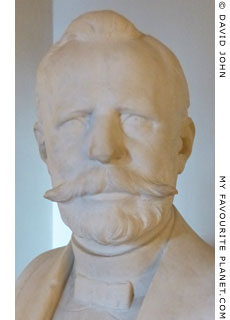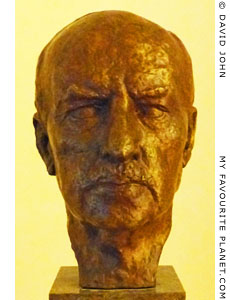1. Carl Humann and the rebuilding of Pythagorio harbour
The few historical sources we have found so far concerning Carl Humann's involvement in the rebuilding of Tigani harbour are quite vague, ambiguous or contradictory. The project appears to have taken from 1842 to 1862, however Humann first arrived on Samos in 1861 and stayed no longer than a year, during which time he was also involved in the archaeological excavations at the Heraion.
He had moved to the warmer climate of the Aegean because he was suffering from tuberculosis. His elder brother Franz Humann (1832-1893) was working here as an engineer for the Ottoman Empire, and helped him find work. Other sources name the brother Wilhelm (Franz Wilhelm, perhaps?) and state that he was a "building entrepreneur" or even a "Roman Catholic minister". It is unlikely that he was a priest, but rather that, as the engineer in charge of planning and construction of various works on the island, he may have had a particular title (something like Minister of Public Works?) in the nominally autononomous Principality of Samos of 1834–1912 (Turkish, Sisam Beyliği; Greek, Ηγεμονία της Σάμου).
Tigani-born Miltiadis Aristarchis (Μιλτιάδης Αριστάρχης 1809-1893) was the Ottoman-appointed Prince of Samos from 1859 to 1866. As part of his attempt to make his hometown the capital of Samos he ordered the rebuilding of the port and redesign of the street layout. However, his strict policies and tax system made him very unpopular with the islanders. Following his use of the Ottoman army to suppress a rebellion in Mytilini (north of Pythagorio), he was overthrown by a popular uprising in 1866.
Carl Humann has also been credited by some sources with discovering the ancient harbour of Polykrates.
His experience in Samos appears to have awakened his interest in classical archaeology, and he travelled to many ancient sites in Turkey. Famously, his fascination for Pergamon began while he was working as the supervising engineer on road construction, and stayed in Bergama during the winter of 1864-65. He was eventually able to gather the necessary support and funds, expert help and official Ottoman government permits to carry out successful excavations at Pergamon from 1878 to 1886.
* The bust of Carl Humann was unveiled on 18 December 1901, when Kaiser Wilhelm II opened the first Pergamon Museum (demolished in 1908). In the present Pergamon Museum (opened 1930) it has been relegated to a back-lot, and has stood for years out of sight and inaccessible to the public, in a corridor leading to a lecture room behind the Pergamon Altar, opposite the bust of another German archaeologist, Theodor Wiegand (1864-1936, see photo below right). Wiegand also excavated at the Heraion on Samos (1910-1911) and at Pergamon (1927), and in 1898 rediscovered the site of the ancient Panionion, near the Turkish village of Güzelçamlı, on the coast opposite Samos (see gallery page 29).
Currently the hall of the Pergamon Altar and the entire left wing of the Pergamon Museum are closed for renovation work until at least 2020. |
| |

A bust of Carl Humann
by Adolf Brütt (1855-1939) * ,
Pergamon Museum, Berlin. |
| |

Miltiadis Aristarchis,
Prince of Samos. |
| |

A bust of Theodor Wiegand
by Carl Blümel,
Pergamon Museum, Berlin. |
|